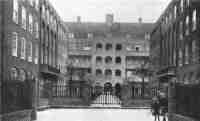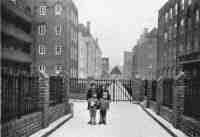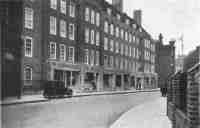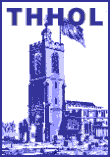The Wapping housing scheme, which was undertaken by the London County Council, and begun in January 1926, is now almost completed, and no doubt Copartners will be interested to know a few general details about the estate and the work done by the Company [i.e. the Commercial Gas Company who produced "The Copartnership Herald"] in order to provide the necessary gas service.
 The
area occupied by the estate originally consisted mostly of slum dwellings, derelict buildings,
and waste ground, and, in the course of the clearance work, Lowder Street, Love Lane, Raymond
Street, and part of Red Lion Street were closed. These names are doubtless well-known by some
of our readers. During the building operations sections of Old Gravel Lane, Greenbank, Watts
Street, Prusom Street, and Red Lion Street were widened by the Stepney Borough Council, so as
to improve the ways of approach, a fitting conclusion to this work of transformation.
The
area occupied by the estate originally consisted mostly of slum dwellings, derelict buildings,
and waste ground, and, in the course of the clearance work, Lowder Street, Love Lane, Raymond
Street, and part of Red Lion Street were closed. These names are doubtless well-known by some
of our readers. During the building operations sections of Old Gravel Lane, Greenbank, Watts
Street, Prusom Street, and Red Lion Street were widened by the Stepney Borough Council, so as
to improve the ways of approach, a fitting conclusion to this work of transformation.
The estate contains 824 flats, arranged in twelve blocks, which are referred to as Houses, and named after famous seamen, voyagers, and discoverers, who, in years gone by, sailed from Ratcliff to seek adventure on the high seas.
The Houses are set well apart, thus giving plenty of light and air to the rooms, and a tar-paved courtyard adjoining each House provides excellent facilities for drying the household washing. With an eye for beauty, the London County Council has laid out a number of flower beds, interspersed with patches of green turf.
A main staircase gives access to each House, with balcony landings leading off to each floor. The flats are of the usual type - two or three bedrooms, living-room, kitchen and bath, etc.
 Included
in the scheme are eleven shops situated in Old Gravel Lane, where residents may purchase their
smaller requirements, the district market being in Watney Street, Shadwell.
Included
in the scheme are eleven shops situated in Old Gravel Lane, where residents may purchase their
smaller requirements, the district market being in Watney Street, Shadwell.
Adjoining the estate is the Wapping Recreation Ground, which contains an open-air gymnasium, a sports ground, and a bandstand which, in addition to providing accommodation for musicians, is used for open-air classes for school children in the summer.
Shadwell Park (King Edward Memorial Park) - an oasis in the centre of dockland, bordered by the river - is within easy walking distance, and there one may see happy children at their play. The Wapping Station of the East London Railway is within two minutes' walk, and provides ready access to all parts of London. When the site was partly cleared, work was begun on No. 1 Block, Willoughby House, followed by other blocks in rotation, the average time taken in the erection of each being about nine months.
 The
London County Council decided that gas should be used for cooking and heating. The necessary
arrangements were accordingly made with the Company to provide prepayment meters, cookers, bracket,
and a point for a gas heater in each flat.
The
London County Council decided that gas should be used for cooking and heating. The necessary
arrangements were accordingly made with the Company to provide prepayment meters, cookers, bracket,
and a point for a gas heater in each flat.
During the erection of each block, the mains and services were laid, outlet pipes run, meter, cookers and fittings fixed, tested and made ready for use as the tenants moved in. The Company has now installed 824 cookers, 138 heaters, 324 brackets and a number of gas coppers.
A list of the houses comprising the Wapping Housing Estate.
- Willoughby House.
- Sir Hugh Willoughby was appointed captain of a fleet of three ships, which set out in 1553, with the object of discovering a north-eastern passage to Cathay and India. Two of the three ships reached the coast of Lapland, where it was proposed to winter. Soon after January, 1554, Willoughby and his companions died of starvation, and a few years later their remains were found, together with Willoughby's Journal, which is printed in the first volume of Richard Hakluyt's famous Principal Navigations.
- Chancellor House.
- Richard Chancellor was appointed captain and pilot-general of the Bonaventure in Sir Hugh Willoughby's expedition. His ship became separated from the others in a storm and he went on alone into the White Sea, from whence he travelled to the Court of Moscow. He was lost in a shipwreck off the coast of Aberdeen in 1556.
- Flinders House.
- Matthew Flinders, hydrographer, navigator, and explorer, was born in 1774. He went as midshipman in the Relianceto New South Wales in 1795, and spent his time studying the outlines and bearings of the Australian coast. After several other voyages undertaken for scientific purposes, he was taken prisoner by the French at Mauritius and was kept in captivity for six years, during which time his health was ruined. He died in 1814.
- Frobisher House.
- Sir Martin Frobisher made the first of his many famous voyages in 1554. He was in command of the Triumph, fighting against the Spanish Armada. In 1594 he took part in the expedition for the relief of Brest and Crozon, and received a wound from which he afterwards died at Plymouth.
- Franklin House.
- Sir John Franklin, the noted Arctic explorer, was born in 1786. He set out to discover a north-west passage to the Pacific in 1845. The ships were last seen near the entrance to Lancaster Sound, and no traces of the party were found until 1851. Franklin showed the existence of the North-West Passage, and his work resulted in the discovery of a second North-West Passage in 1850.
- Fenner House.
- Captain Thomas Fenner, "a most excellent officer," served as Vice-Admiral to Sir Francis Drake in the fleet that set out in 1588 against the famous Spanish Armada. He was in command of the Dreadnought when he was mortally wounded in the attempt on Lisbon in the following year.
- Jackman House (and Shops).
- Charles Jackman took part in three voyages with Stephen Burrough and Arthur Pet, in small craft of 50 tons and under, to carry out an examination of the straits which lead into the Kara Sea in the North East of Russia.
- Parry House.
- Sir William Edward Parry, who was born in 1790, did good service in preparing the way for the eventual discovery of the North Pole. He made valuable charts of the northern seas. Parry was a great friend of John Franklin. He died in 1855, and a memoir of him was published by his son Edward Parry in 1857.
- Beechey House.
- Frederick William Beechey was born in 1796. He was with Franklin in the North Polar Expedition of 1818; with Parry in 1819; and co-operated with them in 1825. Beechey Island, in Barrow Strait, is named after him. He died in 1856.
- Vancouver House.
- George Vancouver, who was born in 1758, accompanied Captain Cook in his second and third voyages, lie was engaged, in 1791-92, in exploring a part of the north-west coast of North America, including the island that was named after him.
- Welsh House.
- James Welsh, master of the Richard of Arundel, voyaged in 1588-91 to the river
of Beam in West Africa. On 18 December 1591 he wrote in the log: "God be praised, we ankered
at Limehouse in the Thames, where we discharged 587 sacks of peper, 150 elephants' teeth,
and 82 barrels of oil of palm trees."
by A.C.G.
